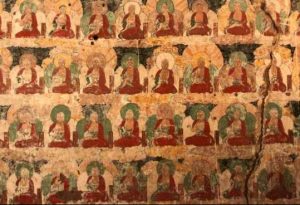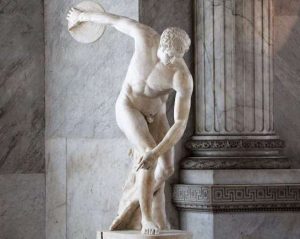
The history of Buddhism is populated by great scholars and masters who attained realization, established teaching lineages—sometimes dance lineages—and then, they died. This is predictable. What happens next is not, but usually follows one of a number of leadership-transition scenarios, most of them classic, whether culminating in success or failure. If the successor leader is not sufficiently adept, the lineage may die out, become diluted into something lesser, or become a vehicle for something entirely new.
We see contemporary examples of these transitions surrounding the advancing age of His Holiness the Dalai Lama and the future leadership of Tibetan Buddhism. It can also be seen in the worldwide Dzogchen community founded by Chogyal Namkhai Norbu, who died several years ago, leaving a set of sacred dances for posterity.
There is a parallel in the world of dance when seminal leaders die or step down. What happens next? Perhaps the most Zen response to this great question was answered by modern dance giant Merce Cunningham, who willed before he died that his dance company be disbanded and that his choreography not be performed by anyone other than the few other companies that Cunningham had permitted to perform specific pieces.
This brings to mind a wonderful Zen story.
An old master was on his deathbed. He called to his side his foremost disciple, to whom he would entrust his Zen teachings. The old master took out a book of his wisest thoughts and handed it to his disciple. The disciple received the book, and promptly threw it into the fire where it burned. “I don’t believe my eyes!” shouted the old master as he died. The disciple answered, “I don’t believe my ears.”
Taiwan’s seminal modern dance company, the Cloud Gate Dance Theatre of Taiwan, was founded in 1973 by a brilliant man of letters and art, Lin Hwai Min. As skillful an author as a choreographer, Lin is a man of profound thought about Taiwanese identity, Buddhism, and universality in art. Cloud Gate embodied a living connection to ancient Chinese principles and aesthetics, even in its lofty classical name. Cloud Gate brought Lin’s choreography to the world for many years, featuring a new style of choreography in concert dance—something Lin asserts is a truly Chinese modern dance, with nothing borrowed from the West.

The company underwent a change in leadership in 2020 that was well planned and a long time coming. Like the king of Bhutan abdicating and gracefully acceding power to a new generation, Lin Hwai Min, who is considered the father of Taiwanese culture, stepped down. He cares deeply about Taiwan, about the generations of dancers, and about the continuity of the company. The new leader, Cheng Tsung-lung is a man of different talents. The results of this succession represent a return to basics, aspiring toward the founding principles that include engaging “with local history, culture, and subject matter, and drawing on classical, folk and modern dance from both the Western and Asian traditions. The dancers train in meditation, chi gong, internal martial arts, modern dance and ballet.” Cheng has added street dance to this.
The problem is that a great and unique artist, a profound thinker, passed his dance company on to a wholly different type of person. It is hard to pass on high-mindedness unless it is already there. The result is that the mission statement, which once was expressed in sublime and beautiful danced essays on spirit and humanity, has now taken shape as a mélange of movement forms. Lin created a seamless style, a true unification of ideas expressed as concert dance, a fundamentally Western modality. Cheng’s choreography for 13 Tongues, choreographed in 2016 and presented at Chicago’s beaux-arts Auditorium Theater, is syncretic, choppy, and difficult to follow. I lost count of the times a sequence would end with a dancer dancing ever more frenetically, until finally running to an edge of the stage and, literally, screaming.
Dancers wearing black costumes dance on a black stage with a black backdrop. It looked like a lot of forearms and shins jutting about. It looked like a drawing board. The artistic concept for the piece was undeveloped, vague, and challenging to execute. The visuals were clunky. It didn’t look like the sophisticated Cloud Gate of old, it looked like any company, mixing up a number of styles. If this company is training in internal martial arts and meditation, it wasn’t apparent in their dancing. Cloud Gate used to dance in a manner like no other. This same fate befell the Joffrey Ballet, which changed directors after the founders died, and a company that once danced like no other, now looks like any other.
Do religious lineages suffer the same fates? Do distinctions between various types and schools of Buddhism blur into uniformity over time? In Bhutan, the Drukpa Kagyu order has taken over failing lineages in the Sakya and Nyingma orders. This is a way to prevent the lineages from dying out entirely, and also a way to blunt the distinctions between transmitted practices. It is not so much a case of the torch being passed, as an intervention designed to avoid total extinction. In both of these cases in Bhutan, the Drukpa Kagyu order took responsibility for the Sayka and Dorje Lingpa dances as well: having their monks learn the dances and document them, and later, perform them in another context.
Perhaps Merce Cunningham was right: the only way to see his choreography as it was intended was to see it when he was alive to guide it. What about a 600-year-old Buddhist dance? Most such dances have one personality associated with them: the founding teacher. These dances appeared in dancing cultures that did not change things, especially religious practices such as sacred dance. A personality established the dances, a community was entrusted to pass them on. Now some of these communities—both monastic and village-based—are themselves threatened. Person-to-person transmission is more frequently augmented with documentations to bolster collective memory.
Thanks to the visionary leadership at the Harris Theater for Music and Dance, Chicago was recently graced with an unusual dance transmission/transition performance of The Rite of Spring, the notoriously groundbreaking ballet choreographed by the legendary Vaslav Nijinsky in 1913 and set to music by Igor Stravinsky. At the premiere, the audience revolted, the police were called, and the theater was shut down. A new day in art was emerging. This radical piece of music has been tackled by a number of choreographers since. German tanztheater artist Pina Bausch choreographed it in 1975 for her company Tanztheater Wuppertal, one of her earliest pieces.

It is important to note what a towering genius Pina Bausch was. She revolutionized concert dance with epic tanztheater pieces of avant-garde performance. In the 1980s, I performed with a Japanese company, DUMB TYPE, on the same international circuit of avant-garde performance. I saw her work many times. I consider this a treasure. To this day, I can call to mind the indelible images she imprinted on my psyche. Bausch was known for her company made of dancers from anywhere, any tradition. She was about the fundamental humanity of movement. She did not shy from the remnant tragedies of post-World War Two Europe. Pina Bausch was a philosopher working in dance. Her company always had some older dancers in it. Bausch died suddenly and unexpectedly in 2009. Whatever else, the Bausch legacy is not stale, and is ascending to a universality.
Today, her Rite of Spring it is being performed by a company composed of dancers from throughout Africa, taught by the Bausch company in Senegal at the École des Sables. The universality of experience is the message. The execution revealed a down-to-earth reality: these African dancers are doing Western dance. Bausch’s Rite of Spring uses classical ballet movements—particularly in the arms—for what reason? Even the original choreography in 1913, by the most famous ballet dancer in the world, did not use ballet to express an elemental ritual. Doing repetitive ballet steps faster and faster in an ever more exhausting way is just that, not a metaphor for the common ground of dance, nor anything remotely like an actual ritual, which clearly this portends to be, of whatever type. The African dancers had no problem with the ballet and tanztheatre staging. They were well-trained, excellent performers, akin to any other professional concert dancers.

People performing ballet look like people performing ballet. There was nothing particularly African about the dancing, except that the opportunity to see so many beautiful African dancers is rare. The company was beautiful. The choreography has a lot of problems, from repetitive steps, to a superfluous dirt covering over the entire floor, to gratuitous and wanton sexual intercourse simulated on stage and the targeted woman tearing out her breasts before falling in the dirt. This is as hokey and unassimilated into a whole work of art as the “hi-yah” steps in Cheng’s 13 Tongues. A good deal of Bausch’s Rite has random people, either huddled in “movement choirs” doing the same choreography again and again, or dotting the stage, just standing there, doing nothing, adding nothing. It is not her best work by a mile. It does require something of the tanztheater performance aesthetic from the performers—a kind of artistic self-consciousness—that was missing from this straightforward mounting of her piece on another company. Overall, I tend to see Bausch’s Rite as a historical work, an example of earlier ways of dance-making. The influence of her teacher, Kurt Jooss, is strong in Rite. It is an incredible piece.
The weirdness of both of these pieces, 13 Tongues and Rite of Spring, as expressions of elemental human sensibilities is that they careen into dancers dancing ever more maniacally until they scream or fall over in the dirt. Fast, faster, more insane, crash! Again and again. This is not great art. These efforts seem inadequate as ways to evoke the founder, their manner of dancing, and their profound assimilation of elements within themselves. There was an atmosphere almost holy about some of Lin Hwai Min’s works. Pina Bausch at her best will have you artistically well-fed, left with a mind adorned with lingering images from the sheer artistry of her work. The Great Mind seems to be hovering about in these transitions, not inherent. How does the Great Mind transmit, especially when the lineage is based on exceptional personalities?

Returning to the mythic creators of the original 1913 Rite of Spring: Sergei Diaghilev, Igor Stravinsky, and Vaslav Nijinsky—how could anyone match that? Yet, the reconstruction of this ballet by Millicent Hodson and Kenneth Archer for the original Joffrey Ballet, which is now part of the repertory of a number of world-class ballet companies, truly does transmit the power of the universal ritual as expressed in the stage arts. It is a complete and whole work of art, even as a reconstruction. Passing the torch in lineage transmissions is a fraught affair. Ècole des Sable’s performance of Bausch’s The Rite of Spring is a lauded international success. The sold-out Chicago audiences roared their praise in standing ovations that wouldn’t end. And so Bausch lives on. Nijinsky’s myth expands. Stravinsky’s groundbreaking score breaks more ground. The world wants more. Those entrusted with the legacy of Pina Bausch will respond.

In an interview at the Arts Club of Chicago, Germaine Acogny, the septuagenarian founder of École des Sables in Senegal, the company that performed so beautifully Bausch’s Rite, said: “This is not about black and white, colonial and subject, north and south. Perhaps it is about my relationship to Stravinsky? Perhaps it is about Pina and me; perhaps it is about two women? Every culture should perform Rite of Spring. Pina and I talked about dance itself. Not any type of movement. What is dance? It’s not war. Dance can do what politicians cannot. Dance is an art where no one is wrong. Dance is common ground.”
See more
Related features from BDG
Fantasy Dinner Party: Arthur Waley and Beryl de Zoete
Codes of Conduct, Ways of Life
Be Inspired
Jardin aux Lilas, the First Zen Ballet
Dance in the Reality You Have












